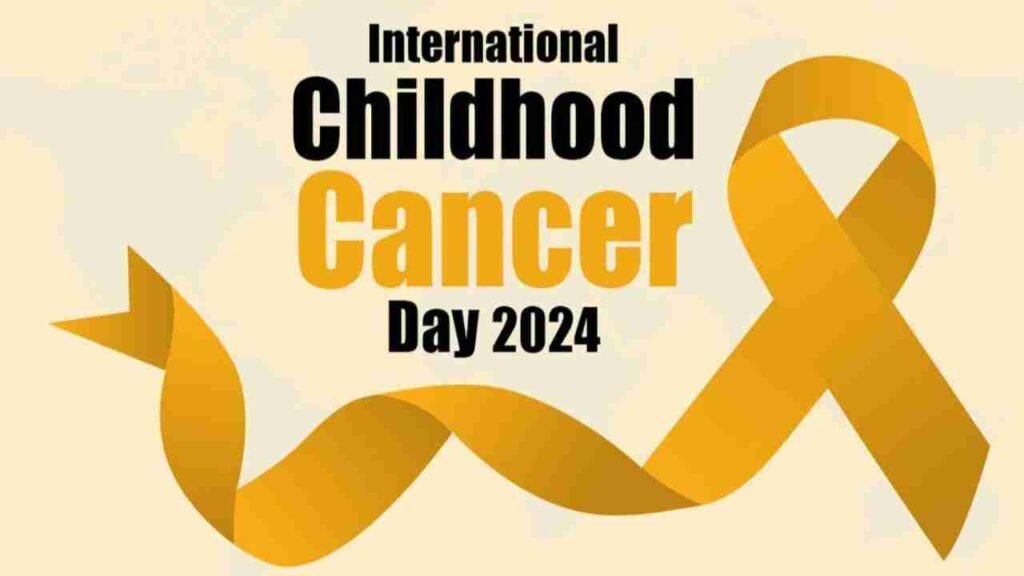Today, February 15th, marks International Childhood Cancer Day, a day dedicated to raising awareness about childhood cancer and advocating for improved diagnosis, treatment, and support for young cancer patients and their families. According to the World Health Organization (WHO), childhood cancer is a leading cause of death among children globally, highlighting the urgency of understanding its common types and early warning signs. In this blog post, we’ll explore some of the most prevalent types of childhood cancer and the signs parents and caregivers should watch out for.

Types of Childhood Cancer:
- Leukemia: Leukemia is the most common type of childhood cancer, accounting for about 30% of all cases. It affects the blood and bone marrow, leading to an overproduction of immature white blood cells. The two main types of leukemia in children are acute lymphoblastic leukemia (ALL) and acute myeloid leukemia (AML).
Leukemia, often referred to as blood cancer, is a type of cancer that originates in the bone marrow, where blood cells are produced. It is the most prevalent form of childhood cancer, constituting approximately 30% of all childhood cancer cases. Leukemia disrupts the normal production of blood cells, leading to an excessive proliferation of immature white blood cells. This abnormal proliferation crowds out healthy blood cells, impairing the body’s ability to fight infections and causing various other complications.
There are two primary types of leukemia commonly diagnosed in children: acute lymphoblastic leukemia (ALL) and acute myeloid leukemia (AML).
a . Acute Lymphoblastic Leukemia (ALL): ALL is the most common type of leukemia in children, comprising approximately 75-80% of all childhood leukemia cases. It primarily affects lymphoid cells, a type of white blood cell responsible for fighting infections. In ALL, immature lymphoid cells proliferate rapidly in the bone marrow and often spill into the bloodstream. Without treatment, ALL progresses rapidly and can be life-threatening. However, with timely and appropriate medical intervention, the cure rates for childhood ALL have significantly improved over the years, with many children achieving long-term remission and survival.
b. Acute Myeloid Leukemia (AML): AML is less common in children compared to ALL, accounting for around 15-20% of childhood leukemia cases. It originates in the myeloid cells, which give rise to red blood cells, platelets, and certain types of white blood cells. In AML, abnormal myeloid cells accumulate in the bone marrow, disrupting normal blood cell production. AML progresses rapidly and requires prompt treatment to prevent complications. While the prognosis for childhood AML is generally not as favorable as for ALL, advancements in treatment protocols and supportive care have improved outcomes for many patients.
Both ALL and AML present with similar symptoms, including fatigue, weakness, pale skin, fever, frequent infections, easy bruising or bleeding, bone pain, and swollen lymph nodes. Diagnosis typically involves blood tests, bone marrow aspiration, and imaging studies to confirm the presence of leukemia cells and determine the extent of the disease.
Treatment for childhood leukemia often involves chemotherapy, targeted therapy, radiation therapy, and, in some cases, stem cell transplantation. The treatment approach may vary depending on factors such as the type of leukemia, the child’s age and overall health, and the presence of specific genetic abnormalities. Multidisciplinary care involving pediatric oncologists, hematologists, nurses, psychologists, and other healthcare professionals is crucial to ensuring comprehensive and personalized care for children with leukemia.
In conclusion, leukemia remains a significant health concern in pediatric oncology, but advances in research and treatment have significantly improved outcomes for affected children. Early detection, timely intervention, and ongoing support are essential in the management of childhood leukemia, emphasizing the importance of raising awareness and promoting access to high-quality healthcare services for all pediatric cancer patients
- Brain and Central Nervous System Tumors: Brain tumors are the second most common type of childhood cancer. These tumors can develop in various parts of the brain and central nervous system, including the cerebellum, brain stem, and optic nerve. Common types include medulloblastoma, astrocytoma, and ependymoma.
Brain and central nervous system (CNS) tumors represent a significant category of childhood cancers, ranking as the second most common type after leukemia. These tumors originate from abnormal growths of cells within the brain or spinal cord and can occur in various regions, including the cerebellum, brain stem, optic nerve, and other areas of the CNS. Understanding the types of brain tumors prevalent in children and their characteristics is crucial for early detection and effective treatment.
a. Medulloblastoma: Medulloblastoma is one of the most common malignant brain tumors in children, typically arising in the cerebellum, the part of the brain responsible for coordination and movement control. This fast-growing tumor mainly affects children aged between three and eight years old. Common symptoms include headaches, nausea, vomiting, unsteady gait, and problems with balance and coordination. Treatment typically involves surgery to remove as much of the tumor as possible, followed by chemotherapy and radiation therapy. Prognosis varies depending on factors such as tumor size, location, and molecular subtype, but advancements in treatment have significantly improved survival rates in recent years.
b. Astrocytoma: Astrocytomas are tumors that originate from astrocytes, star-shaped cells that provide support and nourishment to neurons in the brain. These tumors can vary in severity, from low-grade (benign) to high-grade (malignant) forms. Astrocytomas can develop in various parts of the brain and spinal cord and may cause symptoms such as headaches, seizures, changes in behavior or personality, and difficulties with motor function or vision. Treatment options depend on the tumor grade, size, and location and may include surgery, chemotherapy, and radiation therapy. Prognosis varies widely, with some low-grade astrocytomas being successfully managed with conservative approaches, while high-grade tumors often require more aggressive treatment strategies.
c. Ependymoma: Ependymomas arise from ependymal cells lining the ventricles of the brain or the central canal of the spinal cord. These tumors can occur in both children and adults but are more commonly diagnosed in children. Symptoms may include headaches, nausea, vomiting, changes in vision or balance, and weakness or numbness in the limbs. Treatment typically involves surgery to remove the tumor, followed by radiation therapy and chemotherapy, particularly for high-grade tumors or cases with residual disease. The prognosis for ependymoma varies depending on factors such as tumor location, grade, and extent of surgical resection.
Other less common types of brain tumors in children include gliomas, craniopharyngiomas, and primitive neuroectodermal tumors (PNETs), each with its own unique characteristics and treatment considerations.
In summary, brain and CNS tumors pose significant challenges in pediatric oncology, requiring a multidisciplinary approach to diagnosis, treatment, and supportive care. Advances in imaging technology, surgical techniques, and targeted therapies have led to improved outcomes for many children with brain tumors, underscoring the importance of ongoing research and collaboration in the field of pediatric neuro-oncology. Early detection, timely intervention, and comprehensive care are essential in maximizing the chances of successful outcomes and improving the quality of life for children affected by these complex and often devastating diseases.
- Neuroblastoma: Neuroblastoma is a cancer that develops from immature nerve cells, usually in the adrenal glands or nerve tissue along the spine, chest, abdomen, or pelvis. It is most commonly diagnosed in children under the age of five.
Neuroblastoma is a rare but significant childhood cancer that arises from immature nerve cells, known as neuroblasts. These cells are part of the sympathetic nervous system, which regulates automatic bodily functions such as heart rate, digestion, and response to stress. Neuroblastoma typically develops in the adrenal glands, located on top of the kidneys, but can also occur in nerve tissue along the spine, chest, abdomen, or pelvis.
Pathogenesis: The exact cause of neuroblastoma is not well understood, but it is believed to result from genetic mutations or abnormalities that disrupt the normal development of neuroblasts during fetal development. These mutations lead to uncontrolled growth and proliferation of immature nerve cells, forming tumors that can vary in size and aggressiveness.
Epidemiology: Neuroblastoma primarily affects young children, with the majority of cases diagnosed before the age of five. It is one of the most common solid tumors in infants, accounting for around 6-10% of all childhood cancers. Neuroblastoma incidence rates vary by age, with the highest incidence occurring in infants under one year old.
Clinical Presentation: The clinical presentation of neuroblastoma can vary widely depending on the location and size of the tumor, as well as its spread to other parts of the body. Common symptoms may include:
- Abdominal Mass: A palpable mass or swelling in the abdomen is one of the most common presenting signs of neuroblastoma, often discovered incidentally by parents or healthcare providers during routine physical examinations.
- Bone Pain: Neuroblastoma can spread to the bones, causing bone pain, limping, or difficulty walking.
- Proptosis: In some cases, neuroblastoma may cause bulging of the eyes (proptosis) due to orbital metastasis.
- Fever: Children with advanced neuroblastoma may develop unexplained fevers, which can be a sign of systemic illness.
- Weight Loss and Fatigue: Generalized symptoms such as weight loss, fatigue, and irritability may occur as the cancer progresses.
Diagnosis and Treatment: Diagnosing neuroblastoma typically involves a combination of imaging studies, such as ultrasound, CT scans, or MRI, to visualize the tumor and assess its extent of spread. Blood and urine tests may also be performed to detect elevated levels of certain substances produced by neuroblastoma cells, such as catecholamines or neuron-specific enolase (NSE).
Treatment for neuroblastoma depends on several factors, including the child’s age, the stage and aggressiveness of the tumor, and its response to initial therapy. Options may include surgery to remove the tumor, chemotherapy, radiation therapy, targeted therapy, and stem cell transplantation. Treatment plans are often individualized based on the specific characteristics of each case and may involve a multidisciplinary team of specialists, including pediatric oncologists, surgeons, radiation oncologists, and supportive care providers.
Prognosis: The prognosis for neuroblastoma varies widely depending on factors such as tumor stage, age at diagnosis, genetic markers, and response to treatment. Overall, neuroblastoma has a relatively high survival rate compared to some other childhood cancers, particularly for localized or low-risk tumors. However, advanced or high-risk neuroblastoma can be more challenging to treat and may have a poorer prognosis.
In conclusion, neuroblastoma is a complex childhood cancer that requires careful evaluation and management by experienced healthcare providers. Advances in diagnostic techniques, risk stratification, and treatment modalities have led to significant improvements in outcomes for many children with neuroblastoma, but ongoing research is needed to further refine treatment approaches and enhance long-term survival rates. Early detection, timely intervention, and comprehensive care remain essential in optimizing outcomes and improving the quality of life for children affected by this disease.
- Wilms Tumor: Wilms tumor, also known as nephroblastoma, is a type of kidney cancer that primarily affects children. It usually occurs in children around three to four years old and is rare in older children or adults.
Wilms tumor, also referred to as nephroblastoma, is a relatively rare but significant form of kidney cancer that predominantly affects children. This tumor arises from immature kidney cells, specifically from the embryonic cells that give rise to the kidneys during fetal development. Wilms tumor is typically diagnosed in children between the ages of three and four years old, although it can occur in infants and older children as well. It is rare in adults, accounting for less than 1% of all kidney cancers in adults.
Pathogenesis: The exact cause of Wilms tumor is not well understood, but it is believed to result from genetic mutations or abnormalities that disrupt the normal development of kidney cells during fetal growth. These mutations lead to uncontrolled cell proliferation and the formation of tumors within the kidney. Some genetic syndromes, such as WAGR syndrome (Wilms tumor, aniridia, genitourinary anomalies, and intellectual disability) and Beckwith-Wiedemann syndrome, are associated with an increased risk of developing Wilms tumor.
Epidemiology: Wilms tumor is one of the most common kidney cancers in children, accounting for approximately 6-7% of all childhood cancers. It is more prevalent in girls than boys and occurs more frequently in African-American children compared to other racial or ethnic groups. The peak incidence of Wilms tumor occurs between the ages of two and five years old, with very few cases diagnosed in infants under six months of age or children older than six years old.
Clinical Presentation: The clinical presentation of Wilms tumor can vary depending on the size and location of the tumor, as well as its extent of spread. Common signs and symptoms may include:
- Abdominal Mass: A palpable mass or swelling in the abdomen is often the most noticeable sign of Wilms tumor and may be discovered by parents or healthcare providers during routine physical examinations.
- Abdominal Pain: Some children with Wilms tumor may experience abdominal pain or discomfort, especially if the tumor grows large enough to press against surrounding organs or nerves.
- Hematuria: Blood in the urine (hematuria) may occur in some cases of Wilms tumor, although it is less common than other symptoms.
- Hypertension: High blood pressure (hypertension) can develop as a result of certain hormones produced by the tumor or due to compression of blood vessels within the kidney.
- Fever and Malaise: Children with Wilms tumor may experience nonspecific symptoms such as fever, fatigue, or malaise, particularly if the tumor causes systemic inflammation or affects kidney function.
Diagnosis and Treatment: Diagnosing Wilms tumor typically involves a combination of imaging studies, such as ultrasound, CT scans, or MRI, to visualize the tumor and assess its extent within the kidney and surrounding tissues. Blood tests may also be performed to evaluate kidney function and detect any abnormalities in blood cell counts or electrolyte levels.
Treatment for Wilms tumor usually involves a combination of surgery, chemotherapy, and sometimes radiation therapy, depending on the stage and characteristics of the tumor. Surgical removal of the affected kidney (nephrectomy) is typically the primary treatment approach, followed by chemotherapy to eliminate any remaining cancer cells and reduce the risk of recurrence. Radiation therapy may be recommended in certain cases to target residual tumor cells or prevent local recurrence.
Prognosis: The prognosis for Wilms tumor is generally favorable, with cure rates exceeding 90% for children with localized or early-stage disease. However, prognosis may vary depending on factors such as tumor stage, histology (cellular characteristics), age at diagnosis, and response to treatment. Overall, advances in diagnostic techniques, treatment protocols, and supportive care have significantly improved outcomes for children with Wilms tumor, emphasizing the importance of early detection and comprehensive management by a multidisciplinary team of healthcare providers.
In conclusion, Wilms tumor is a rare but treatable form of kidney cancer that primarily affects children. Early diagnosis, prompt intervention, and multidisciplinary care are essential in optimizing outcomes and improving the quality of life for affected children and their families. Ongoing research into the underlying causes and mechanisms of Wilms tumor is critical for developing more effective treatment strategies and ultimately achieving better long-term survival rates for all patients.
- Lymphoma: Lymphoma is a cancer of the lymphatic system, which is part of the body’s immune system. The two main types of lymphoma in children are Hodgkin lymphoma and non-Hodgkin lymphoma.
Lymphoma is a type of cancer that originates in the lymphatic system, which plays a crucial role in the body’s immune response by producing and circulating lymphocytes (white blood cells) and lymph fluid throughout the body. Lymphoma occurs when abnormal lymphocytes multiply uncontrollably, forming tumors in lymph nodes or other lymphoid tissues. There are two main types of lymphoma: Hodgkin lymphoma (HL) and non-Hodgkin lymphoma (NHL), each with distinct characteristics and treatment approaches.
1. Hodgkin Lymphoma (HL): Hodgkin lymphoma, also known as Hodgkin’s disease, is characterized by the presence of a specific type of abnormal cell called Reed-Sternberg cells within the affected lymph nodes. These cells, along with surrounding inflammatory cells, contribute to the distinctive microscopic appearance of Hodgkin lymphoma under a microscope. Hodgkin lymphoma is relatively rare in children, accounting for approximately 6% of all childhood cancers. It typically occurs in two age peaks: early adulthood (ages 15-40) and late adulthood (over 55 years old), with a smaller peak in adolescence. However, it can occasionally affect younger children, including those under the age of five.
Hodgkin lymphoma often presents with painless swelling of lymph nodes in the neck, armpits, or groin, along with symptoms such as fever, night sweats, fatigue, and unexplained weight loss. Diagnosis usually involves a biopsy of the affected lymph node to confirm the presence of Reed-Sternberg cells and determine the subtype of Hodgkin lymphoma. Treatment typically includes chemotherapy, radiation therapy, or a combination of both, depending on the stage and extent of the disease. Prognosis for children with Hodgkin lymphoma is generally favorable, with high cure rates exceeding 90% for localized or early-stage disease.
2. Non-Hodgkin Lymphoma (NHL): Non-Hodgkin lymphoma comprises a heterogeneous group of lymphoid malignancies that do not contain Reed-Sternberg cells characteristic of Hodgkin lymphoma. Non-Hodgkin lymphoma is more common in children than Hodgkin lymphoma, accounting for approximately 7-10% of all childhood cancers. It can occur at any age, from infancy through adolescence, with different subtypes showing distinct age distributions and clinical features.
Non-Hodgkin lymphoma in children often presents with painless swelling of lymph nodes, similar to Hodgkin lymphoma, but may also involve other organs or tissues, such as the abdomen, chest, or central nervous system. Diagnosis typically involves a combination of imaging studies, biopsy, and molecular testing to determine the specific subtype of non-Hodgkin lymphoma and assess the extent of disease spread. Treatment for non-Hodgkin lymphoma in children may include chemotherapy, targeted therapy, immunotherapy, radiation therapy, or stem cell transplantation, depending on the subtype and stage of the disease. Prognosis varies depending on factors such as tumor biology, stage at diagnosis, and response to treatment, with overall survival rates ranging from approximately 80-90% for children with localized or low-risk disease to lower rates for those with advanced or high-risk disease.
In summary, lymphoma is a diverse group of cancers that affect the lymphatic system, with Hodgkin lymphoma and non-Hodgkin lymphoma representing the two main subtypes. While both types of lymphoma can occur in children, non-Hodgkin lymphoma is more common and may present with a wider range of clinical features and outcomes. Early diagnosis, appropriate treatment, and ongoing surveillance are essential in achieving optimal outcomes and improving the long-term survival and quality of life for children with lymphoma.
Signs of Childhood Cancer:
- Unexplained Weight Loss: Significant and unexplained weight loss in a child could be a sign of various types of cancer, including leukemia, lymphoma, or brain tumors.
- Persistent Fever: A persistent fever that doesn’t go away with usual treatment could be a symptom of leukemia or lymphoma.
- Frequent Infections: Children with leukemia or other types of cancer may experience frequent infections due to a weakened immune system.
- Persistent Headaches: Persistent headaches, especially accompanied by vomiting and changes in vision, could be a sign of a brain tumor.
- Abdominal Swelling or Pain: Swelling or pain in the abdomen, along with other symptoms such as blood in the urine or high blood pressure, may indicate Wilms tumor.
Conclusion: International Childhood Cancer Day serves as a reminder of the importance of early detection and intervention in combating childhood cancer. By understanding the common types of childhood cancer and being aware of the signs and symptoms, parents, caregivers, and healthcare professionals can work together to improve outcomes for young cancer patients worldwide. Let us continue to support research, raise awareness, and provide compassionate care to children battling cancer and their families.
Register for My Upcoming Masterclass HERE
See You in the Live Masterclass
Sunil Chaudhary stands as a preeminent global Leading digital coach, boasting a diverse clientele hailing from over 50 nations. Renowned for his prowess as an exemplary SEO expert, business automation coach, and landing page authority, Chaudhary also holds the distinction of being esteemed as the finest business coach in India. Beyond technical domains, he imparts invaluable insights into mindset, success, and life skills, thus encompassing a holistic approach to mentorship.
Join FREE Courses HERE
Know The Author:
 Sunil Chaudhary aka Suniltams Guruji is India’s Leading Digital Coach. He provides complete Digital Skill Development Coaching with great support. Sunil has trained more than 25000 students and helped more than 1100 businesses so far. Sunil is a well-known face across the world for Digital Coaching.
Sunil Chaudhary aka Suniltams Guruji is India’s Leading Digital Coach. He provides complete Digital Skill Development Coaching with great support. Sunil has trained more than 25000 students and helped more than 1100 businesses so far. Sunil is a well-known face across the world for Digital Coaching.
Digital Success Coach | Best SEO Coach India | Mindset Coach | Life Success Coach
Related posts:
 Exploring the World of Yoga
Exploring the World of Yoga
 Skin Doctor Near Me: Your Go-To Guide for Dermatological Care in India
Skin Doctor Near Me: Your Go-To Guide for Dermatological Care in India
 Understanding the Link Between Dandruff and Facial Health
Understanding the Link Between Dandruff and Facial Health
 Oats vs Millets: Which is a Nutritious Choice?
Oats vs Millets: Which is a Nutritious Choice?
 Demystifying Stubborn Acne: Understanding Causes, Treatment, and Prevention Strategies
Demystifying Stubborn Acne: Understanding Causes, Treatment, and Prevention Strategies
 The Health Benefits of Evening Workouts for People with Obesity
The Health Benefits of Evening Workouts for People with Obesity
 AstraZeneca Acknowledges Rare Side Effect Risk in Covishield Vaccine: Navigating Public Concern
AstraZeneca Acknowledges Rare Side Effect Risk in Covishield Vaccine: Navigating Public Concern
 Is Anger Bad for Your Heart Health? Exploring Reasons and Strategies to Avoid Rage
Is Anger Bad for Your Heart Health? Exploring Reasons and Strategies to Avoid Rage
 Say No to Tea and Coffee Before and After Meals, Advises Top Medical Body ICMR
Say No to Tea and Coffee Before and After Meals, Advises Top Medical Body ICMR








